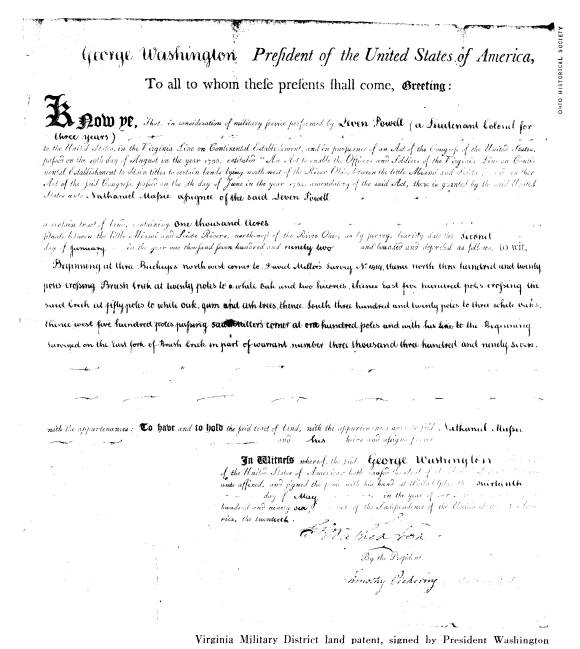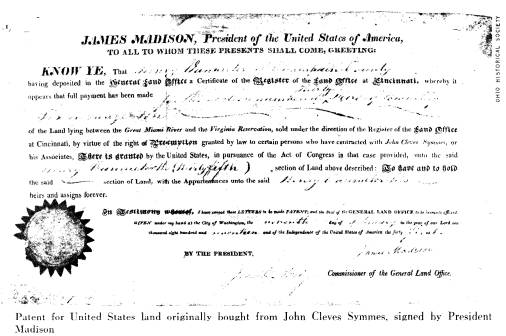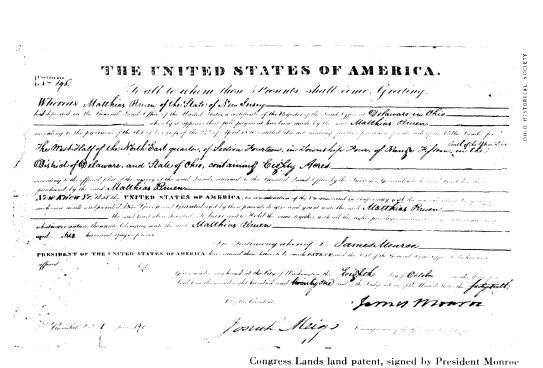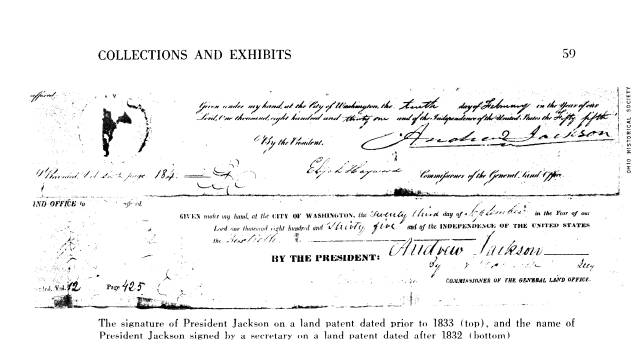Ohio History Journal
|
|
|
COLLECTIONS AND EXHIBITS Ohio Land Patents by KENNETH W. DUCKETT |
|
NOT LONG AGO the public relations office at a United States Air Force base wrote a press release describing a "nineteenth century land deed" owned by one of its civilian employees. According to the re- lease, a local authority had appraised the document, signed by Thomas Jefferson as president of the United States and James Madison as secretary of state, at $25. Autograph collectors, the release con- |
|
tinued, had subsequently made offers of up to $3,000 for it. Such stories make excellent copy, but they also lead to a great deal of un- happiness and misunderstanding. Many people who hold president-signed land patents, after reading such a story, ex- pect to sell them and pay off the mort- gage on the house. On the average of two or three times a week these people |
|
52 OHIO HISTORY |
|
call or write the Ohio Historical Society offering land patents for sale, and they are often shocked to learn that the So- ciety, which has a collection of several hundred accumulated in years past, does not wish to purchase them, and, more often than not, is not even anxious to receive them as gifts. These same per- sons are equally dismayed to find that autograph dealers may offer them as little as $5 for their patent, depending on its condition and which president and other government official signed it. Owners of patents dated after 1832 are usually upset to learn that the president's
name on their patent was almost certainly signed by a clerk and that the patent's monetary value is nil! Land patents, sometimes called land grants, take their name from the English law term "letters patent," which is de- fined as "a writing granting to a person power and authority to do some act or enjoy some right." The
patents for Ohio lands issued by the United States under a number of acts of congress. though varying in form and content, each granted a certain amount of land to a person "to have and to hold" forever. Prior to 1833 each of the estimated eighty-five thousand patents issued for Ohio lands was individually signed by the president and co-signed by either the secretary of state or the commissioner of the general land office. On March 2. 1833, with a backlog of twenty thousand land patents awaiting Andrew Jackson's signature, congress authorized a clerk to sign patents in his name, ending for all time this arduous presidential task. Because of their official nature and content it is easily understood why thou- sands of land patents are still held today by descendants of Ohio pioneer land- owners. But the very fact that they exist in great numbers lessens their monetary value. And while the historical value of |
|
an individual patent is usually slight, collectively they can be said to illustrate the story of the disposition of Ohio's lands, the state's greatest natural resource. The thousands of president-signed land patents for Ohio lands fall into three principal categories: those for lands sold at public auction, those for lands given as compensation for civilian losses in- curred during the Revolution, and those for lands granted as bounties to encour- age enlistment in the Revolutionary armies. Of these three, the greatest num- ber of early patents were issued to Revo- lutionary soldiers and officers for lands in the Virginia and United States mili- tary land districts in Ohio. The colony of Virginia, under its royal charter, at one time claimed all of the present state of Ohio. To encourage men to enlist in its Revolutionary regiments, the colony promised to give a land war- rant to each enlistee redeemable after the war for from a hundred to fifteen thousand acres, depending on the en- listee's rank and length of service. In 1783, when Virginia relinquished its claim to lands north of the Ohio River, it reserved for itself the Virginia Mili- tary District of 3,850,000 acres between the Scioto and Little Miami rivers to satisfy its Revolutionary War bounties. The surveying of the reserve delayed the disposition of the lands, and it was not until 1790 that congress directed the president to issue patents to the Virginia veterans, their heirs, and assigns. The first settlement in the Virginia Military District was Massie's Station (later Manchester), founded in 1791 by Nathaniel Massie. The earliest dated land patent in the Society's manuscript collec- tion is for one thousand acres granted to Nathaniel Massie as the assignee of Lieutenant Colonel Leven Powell. Powell, like so many of his fellow veterans, sold his land warrant to a speculator, Massie, |
|
|
|
Virginia Military District land patent, signed by President Washington who entered it and received the patent for the lands, which he held and no doubt sold later at a profit. Much land in the Virginia Military District remained unclaimed, and con- gress extended the time limit for entries again and again. Finally, in 1852, the Virginia legislature released all further claims to the district to the national gov- |
|
ernment, and twenty years later the un- granted land (76,735 acres) passed by federal act to the state of Ohio, which in turn granted it to the Ohio Agri- cultural and Mechanical College, now Ohio State University. Although not as common as patents issued for lands in the Virginia Military District, thousands were granted by the |
|
54 OHIO HISTORY |
|
federal government in another military land reserve in Ohio, the United States Military Tract. Created by congressional act of June 1, 1796, this tract contained approximately 2,500,000 acres located in the central part of the state. Perhaps because at the time when the central government offered enlistment bounties it held no western lands, the continental congress had been less gen- erous than Virginia: each enlistee, de- pending on rank, was to receive a war- rant redeemable for a hundred to eleven hundred acres. Unlike the warrants for land in the Virginia tract, those offered by the continental congress were not. until after 1788, assignable, and only then under certain conditions. By this date the states had ceded their western lands in Ohio, and the federal govern- ment was in a position to redeem the somewhat empty promises made by the continental congress. As in the Virginia tract, the time limit for claiming lands in the United States Military Tract was extended from time to time. until 1803, when the remaining lands were assigned to the Chillicothe and Zanesville federal land districts to be sold as part of the lands known popularly as "Congress Lands." An early land patent in the Society's manuscript collection signed by President John Adams on June 23, 1800, is an ex- ample of the type issued for lands in the United States Military Tract. It reads in part: ... in pursuance of the act of Congress passed on the first day of June 1796, entitled "An Act regulating the grants of Land appropriated for Military services, and for the society of the United Brethren for propagating the gospel among the Heathen".... All patents issued for lands in the |
|
United States Military Tract contain this phrase, which also serves to illustrate a second type of land patent, that issued as compensation for civilian losses in the Revolutionary War. The reason for granting lands to the United Brethren, or Moravian Church, had its roots in the period 1772-80, when its missionaries settled Christianized Indians in the Mus- kingum River Valley at Schoenbrunn, Gnadenhutten, and Salem. In the fron- tier conflicts between the British and Americans and their Indian allies, the Moravian Indians attempted to remain neutral, but ended by being attacked by both sides and driven from their homes. In 1788, in an effort to get them to re- turn to their villages, congress reserved 4,000 acres around each town to be held by the church in trust "for the sole use of the Christian Indians." For vari- ous reasons the villages did not prosper, and ultimately most of the land was re- turned to the federal government. That other casualties of the Revolu- tion figured in the settlement of Ohio lands is evidenced by another type of land patent.
An example of this type in the Society's manuscript collection, signed by President Thomas Jefferson and dated May 7, 1802, reads in part as follows: ... in pursuance of the act of Congress passed on the eighteenth day of Feb- ruary, 1801, entitled "An Act regulating the grants of Land appropriated for the Refugees from the British Provinces of Canada and Nova Scotia".... The Refugee Tract, created by the act referred to in the patent, set aside 103,000 acres for the relief of residents of Canada and Nova Scotia who because of their sympathy with the American revolutionists were forced to flee their homes. Since little more than half of |
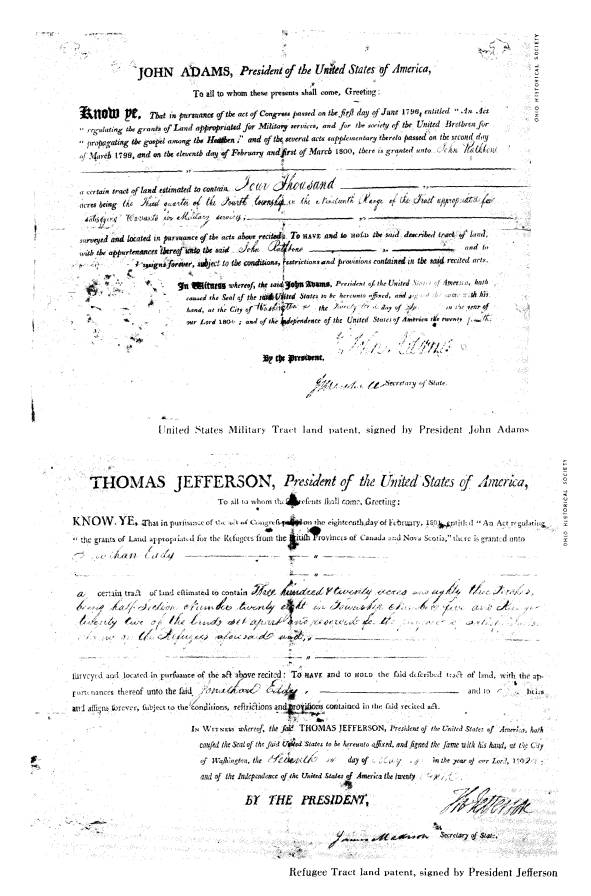
|
56 OHIO HISTORY |
|
|
|
Patent for United States land originally bought from JOhn Cleves Symmes, signed by President Madison the land (which lay in a narrow strip south of the United States Military Tract) was claimed by the refugees or their heirs in the time allowed, in 1812 congress acted to have the remainder sold by public auction at the federal land office in Chillicothe. Civilian losses incurred during the Revolution by inhabitants of Connecticut whose property was burned by the raid- ing British army, also were compensated for by grants of land in Ohio. How- ever, since these grants, in an area adja- cent to Lake Erie known as the Fire Lands, were administered under the laws of Connecticut, which like Virginia claimed western lands, no president- signed patents were issued with their sale. Nor were they issued for the tract of about 3,800,000 acres in northeastern Ohio known as the Connecticut Western Reserve, which the state had reserved to itself when it ceded its lands to the fed- eral government in 1786. Similarly, in the same period, the central government sold by contract two large tracts of Ohio |
|
land, which were resold to individual settlers by the land companies that bought them: 964,285 acres to the Ohio Company and 248,540 acres to John Cleves Symmes and his associates. Naturally, lands purchased by settlers in these tracts were deeded by the re- spective companies, and no president- signed patents exist for these trans- actions. However, because of a mis- understanding as to the boundaries of Symmes's purchase, he sold lands to which the federal government held title, and to protect these purchasers congress granted them preemption rights. As a result, some land patents, of which one held by the Society signed by President James Madison and dated February 7, 1817, is an example, contain this phrase: ... sold under the direction of the Reg- ister of the Land Office at Cincinnati, by virtue of the right of Pre-emption granted by law to certain persons who have con- tracted with John Cleves Symmes, or his Associates .... |
|
COLLECTIONS AND EXHIBITS 57 |
|
All the lands touched upon above were special grants and reserves. The remain- ing lands settled in Ohio prior to 1833 were sold by the federal government. These were the Congress Lands, which took their name from the acts of congress regulating their sale. The land act of 1796, which estab- lished the federal office of surveyor gen- eral, directed that Ohio lands offered for sale under the act were to be advertised in at least one newspaper in each of the states and territories two months prior to the sale. The lands were to be sold at public auction at Cincinnati and Pitts- burgh. The smallest amount of land which could be purchased was 640 acres, a minimum price of $2.00 per acre was set, and the purchaser was allowed a year to complete payment. When the United States Treasury received the pur- chaser's final installment, it certified pay- ment in full to the secretary of state, who in turn issued the land patent to the settler. Depending on the size of the acreage bought, the purchaser paid, in addition to the purchase price, fees of entry ranging from six to twenty dollars, and an equal amount for his patent. By 1800 it was apparent that the act of 1796 was not successful in getting land into the hands of settlers. Less than fifty thousand acres had been sold, only a por- tion of which was Ohio land, and most of it had been purchased by land specu- lators. The Harrison land act (May 10, 1800), named for William Henry Harri- son, the first delegate to congress from the Northwest Territory and chairman of the house committee on public lands, extended the terms of credit to four years, and allowed for the purchase of 320 acres in a unit. Federal land offices were established at Marietta, Chillicothe, Cincinnati, and Steubenville under the direction of registers appointed by the president. Public auctions were to be |
|
held for three weeks in the spring of 1801 at each office, after which time the remaining unentered lands might be sold at private sales. No significant changes were made in the laws regulating land sales in Ohio for the next twenty years, except for the establishment in 1812 of the United States General Land Office under the de- partment of the treasury. After this time, land patents issued for Congress Lands were no longer co-signed by the secretary of state but by the commissioner of the general land office. The last major change prior to 1833 in land laws bearing on the issuance of president-signed land patents was the land act passed by congress in 1820. Under the Harrison land act large num- bers of Ohio settlers had found it im- possible to make the deferred payments on their lands. Other hard-working farm- ers, seeing that the federal government was taking no action to repossess the lands of those who had failed to make their payments, let their own installments lapse. Finally congress in the land act of 1820, moving to stem the growing number of arrears, abolished the credit system for land purchases, set the mini- mum price at $1.25 per acre, and made it possible to buy parcels of as little as eighty acres. With smaller units of land being of- fered for sale after 1820, the number of land patents issued increased sub- stantially, and many of those held today by descendants of Ohio's pioneer settlers have their origin in the provisions of this act. They would read in part as does that in the Society's collection signed by President James Monroe on October 8, 1821: Whereas Matthias Bruen of the State of New Jersey has deposited in the Gen- eral Land Office of the United States, a certificate of the Register of the Land |
|
|
|
Office at Delaware in Ohio whereby it ap- pears that full payment has been made by the said Matthias Bruen according to the provisions of the Act of Congress of the 24th of April 1820, entitled "An act mak- ing further provision for the sale of the Public Lands".... This is a brief account of the public land policy in Ohio up till 1833, when, at Jackson's request, congress acted to re- lieve the president of the time-consuming task of signing land patents. From this time on, with a mere handful of excep- tions, patents were signed in the presi- dent's name by a clerk whose signature appears below the name of the president. In the Society's extensive collection of patents there is only one dated after 1832 which is signed by a president: a grant of land made to an Indian under special treaty provisions. What is the historical and monetary value of president-signed patents? In- dividually or collectively, patents have little intrinsic value as sources for his- torical research. Any serious study of land policy would be made from state and county archives and the records of the United States General Land Office in |
|
the National Archives, not from the col- lections of land patents held by every research library in the country. There is no record of any of these collections of patents having been consulted in the preparation of any major work dealing with land, and patents continue to occupy shelf space in every collection of manu- scripts, usually because most institutions lack the authority to dispose of them. If a patent was issued to a man of im- portance, or if the land which it was is- sued for has historical significance, it should be retained as a possible exhibit piece, but the bulk of the run-of-the-mill patents could more profitably be sold to autograph dealers, who in turn sell them to private collectors of president-signed documents. As to monetary value, the price which an autograph dealer might be willing to offer for a land patent depends on many factors, one of the principal ones being the condition of the document. Patents issued prior to 1833 were printed on parchment, which may have become yel- low and brittle with age, or having been folded and refolded many times, badly creased. Excessive handling may have |
|
|
|
soiled the document, and the ink may have faded. All these factors would de- tract from its monetary value. Unlike some historical artifacts, which increase in value with the natural patina of age. documents which are clear, bright, and fresh command the highest prices. Below is a rough guide to what a dealer might offer for president-signed land patents in good to fine condition: (It should be stressed that these prices are only approximations, and would vary from dealer to dealer depending on their stock of similar documents. The only realistic way of determining the value of an individual document is to send it to a dealer and ask for his offer.) George Washington: $75-$100. Wash- ington-signed grants for Ohio lands would be fairly rare, and one signed also by Jefferson as secretary of state might be worth approximately double one signed by Washington alone. John Adams: $40-$50. If instead of being signed also by Timothy Pickering as secretary of state, the patent is signed by John Marshall, who held that office briefly under Adams, the offer would probably be close to $75. |
|
Thomas Jefferson: $25-$35. A great many of the patents signed by Jefferson during his two terms bear the signature of James Madison as secretary of state, bringing their value to approximately $35 to $50. It is, however, quite possible that if the patent is in poor condition, a dealer's offer may be as low as $10 for a patent signed by both men. James Madison: $7.50-$10.00. Many Madison-signed patents are co-signed by Ohioans Josiah Meigs or Edward Tiffin as commissioner of the general land office, but the signatures of neither of these men raise the value of the docu- ments. However, those Madison-signed patents which are also signed by James Monroe as secretary of state would prob- ably elicit offers of approximately $15 to $20. James Monroe: $5-$10. Commonly co- signed by Josiah Meigs as commissioner of the general land office, those bearing instead John Quincy Adams' signature as secretary of state might be sold at $10 to $20. John Quincy Adams: $5.00-$7.50. These are very common and not much in demand by dealers. |
|
60 OHIO HISTORY |
|
Andrew Jackson: $10-$25. This value applies only to those patents signed prior to 1833, after which time the authority was delegated to clerks, who signed in the president's name. Obviously, the proceeds from the sale of a president-signed land patent cannot be used to pay off the mortgage or send anyone through college, as so many per- sons hope. They are nonetheless inter- esting documents, and can be justly con- sidered as treasured heirlooms by de- |
|
cendants of Ohio pioneer settlers. And while the patent itself rarely has more than a limited historical value, quite fre- quently the trunk in which it has been stored over the years might yield letters, diaries, journals, account books, and other manuscripts which would have great historical value. The Ohio Histori- cal Society is always interested in learn- ing of such manuscripts and in examining them for their historical content. THE AUTHOR: Kenneth
W. Duckett is the curator of manuscripts of the Ohio Historical Society. |

